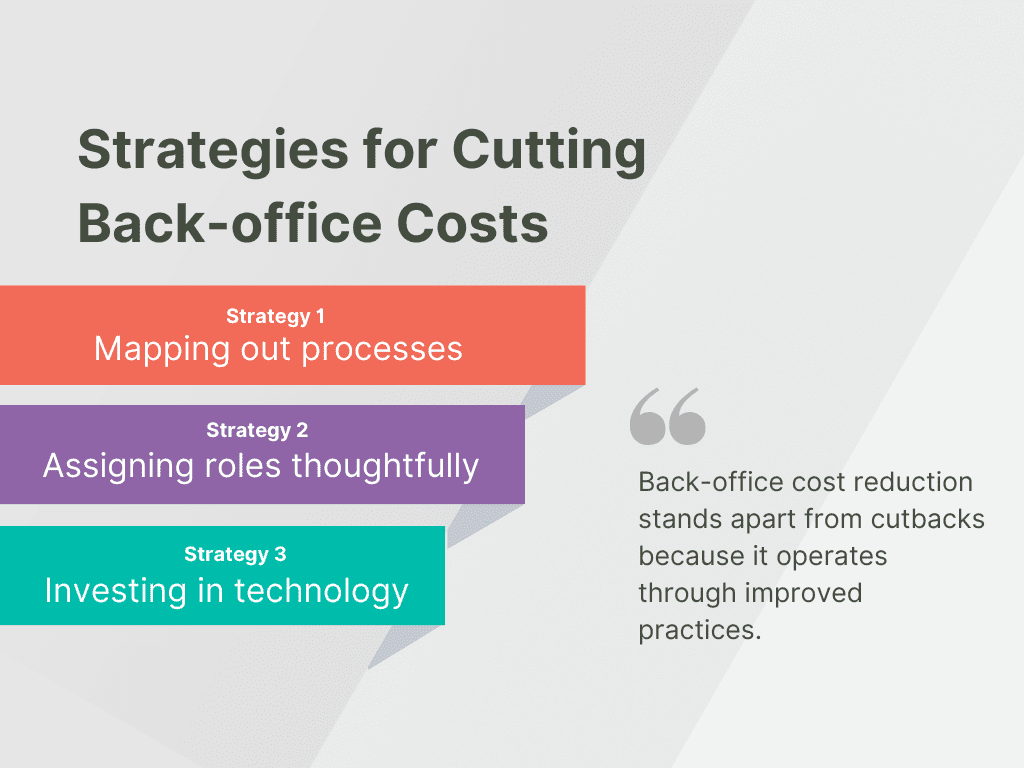Every business depends on key back-office processes such as accounting, HR management, IT support, and inventory control to keep the show running. But here’s the twist: organizations can spend anywhere from $37,000 to over $51,000 a year for back-office personnel costs, which adds up rather quickly. For small and medium-sized businesses operating on tighter budgets, these expenses take a big bite out of profitability.
The challenge? Many of these key functions are clogged up by inefficiencies—mostly compliments of bad system integrations and improper resource allocation. The good news? Back-office automation coupled with intelligent, as well as insight-led decision-making can save companies money and, most importantly, get them working smarter, not harder.
Wondering how that happens? Check out the key takeaways from some very actionable strategies discussed in the recent Synder webinar, “Cutting Back-Office Costs While Boosting Data-Driven Decisions,” and raise your back-office game.
Meet the guest speaker

Matt Tate leads Decimal after a career spanning more than 15 years of technology along with operations and strategic experience. As Decimal’s CEO and Co-Founder, he redesigns financial operations through clear simplification processes and automated systems which enhance overall management effectiveness. His expertise comes from managing organizations through scaling efforts while maintaining agility across rapidly changing business environments.
What are back-office costs?
Back-office costs typically come in two main categories: time and tools. People utilize time to execute all work duties including maintaining books, processing payroll, managing inventory. Tools function as technological elements which automate or streamline operational activities.
As Matt explained: “The biggest cost there is always people and time. The second biggest cost comes from the technology or the tools you use to accomplish the work.”
Most small businesses face back-office inefficiencies because they delegate their tasks to people who lack appropriate skills. Frequently leadership teams at new ventures or developing businesses take on responsibilities beyond what they truly understand.
“Are the right people doing the right tasks? So often, the answer is no, it’s not uncommon to see a business owner handling accounting when their time could be better spent on strategy or growth.”
Such misfit between organizational design and operations hampers productivity and takes companies away from their focus on growth and innovation.
Strategies for cutting сosts without sacrificing quality
Back-office cost reduction stands apart from cutbacks because it operates through improved practices. Companies achieve both reduced inefficiencies and higher quality with the following three approaches:

1. Mapping out processes
To start back-office optimization, you must first understand your process. A step-by-step task mapping approach helps organizations identify inefficiencies caused by duplicate work, manual delays, and outdated tools that lead to production bottlenecks. Breaking the process into manageable chunks makes it easier to set clear selection metrics for time, costs, and operational outcomes.
“Breaking down your processes into a step-by-step basis helps you measure each step and pinpoint inefficiencies. Once you do this, you can allocate resources more effectively,” said Matt.
By embracing transparency, organizations can make better decisions about task reassignments, workflow automation, and tool implementation.
2. Assigning roles thoughtfully
Having the right people doing the right jobs is the key to efficiency. One of the greatest errors is to have senior staff—or even owners—spend time doing low-level back-office tasks that can be outsourced or delegated. This wastes precious hours and keeps them from doing more worthwhile work.
“Often, business owners or senior leaders take on tasks they aren’t suited for,” Matt pointed out. “Delegating effectively can save both time and money.”
By aligning skills and priorities to tasks, businesses can coordinate productivity and free up leadership to focus on strategic growth plans.
Find out what 5 key reports drive strategic growth.
3. Investing in technology
Technology is a game-changer for back-office operations, enabling businesses to eliminate manual steps and drive efficiency. But the tools have to be chosen correctly. It’s not a question of just adding more software—it’s a question of choosing solutions that fit exactly into your processes and eliminate, rather than create, inefficiencies. For example, implementing ITAM software can ensure all your IT assets are tracked, integrated, and optimized, reducing duplication and wasted resources.
“Picking the right tools is really, really important because the right tools integrate well. The wrong tools don’t. If your systems don’t talk to each other, you’ve created more problems than you’re solving,” Matt emphasized.
Poorly integrated tools can create data silos, duplicated work, and wasted debugging efforts. Effective tools, on the other hand, automate, avoid duplication, and scale with your business over the years.
Learn about top accounting software for retail businesses.
Bonus: Leveraging Synder automation to reduce your back-office costs
Automation is one of the most effective methods of minimizing manual effort in back-office functions. Automation of repetitive tasks saves time for companies and reduces errors and frees up employees to perform more valuable tasks. Yet, successful automation does take some planning and execution.
“If you’ve decided to implement automations, pay someone to do it right. The cost of doing it poorly far outweighs the initial investment,” Matt advised.
Software like Synder automate financial and accounting activities, giving businesses real-time insight into their financial situation, which leads to more informed decisions.
The power of Synder for data-driven decisions
Data is at the heart of smarter decision-making, but collecting it is just the first step. Business organizations need to analyze and act on their information in order to see tangible outcomes. Identifying key performance indicators (KPIs) and tracking them in real time can allow businesses to make life-changing choices.
Matt shared an example of how Synder transformed a company’s back-office operations:
“We actually put Synder in place to help them (client) get a more incremental understanding of what they were selling, getting the revenue integrated into the ledger in a better way.”
Matt Tate, CEO of Decimal
Synder does more than just record transactions. Synder connects your multiple sales channels like Amazon or Shopify, payment processors like PayPal or Stripe, and accounting software, whether it’s QuickBooks, Xero or Sage Intacct, to provide you with a unified view of your financial health. With features like automated reconciliation, real-time data tracking, invoicing, business analytics and tax recording tools, Synder ensures your data is both accurate and actionable.
For instance, an $8 million online store utilized Synder to replace outdated spreadsheets. This provided them with insight into product performance and profitability: “They shut down a product they thought was selling really well, but it was actually losing them money. That was a fascinating thing that the data proved out,” Matt explained.
This kind of insight shows how Synder helps businesses spot business opportunities and slash inefficiencies.
Want to see how Synder will streamline your accounting workflow? Sign up for a 15-day free trial or join our Weekly Public Demo for more insights.
Preparing for the future
By addressing inefficiencies and aligning resources through thoughtful process mapping, role assignments, and technology investments, businesses can optimize their current operations and effectively reduce back-office costs. However, cutting-edge strategies don’t stop there. To stay competitive and future-ready, organizations must also learn to embrace the trends that are creating the new shape of the back-office.
The back-office is evolving along two major trends: artificial intelligence (AI) and remote work. Remote work has enabled access to the global pool of talents, enabling businesses to find specialized skills and reduce expenses by hiring remotely. The trend levels the playing field for small and medium-sized businesses when pitted against big corporations.
AI is reshaping efficiency and cutting back-office costs because it’s automating repetitive tasks. Here are some examples:
- Payroll processing: AI systems streamline payroll by calculating wages, taxes, and deductions automatically and maintaining compliance with changing regulations, reducing unnecessary HR intervention.
- Customer support: AI chatbots handle routine inquiries, such as order tracking or FAQs, reducing the need for large customer service teams and enabling human agents to focus on complex issues.
- Document management: Computerization and document organization by AI systems allow for rapid retrieval, minimize the cost of storage space, and eliminate time wasted in manual filing.
- Employee onboarding: AI technology streamlines onboarding by conducting background checks, setting up employee accounts, and sending personalized training materials, reducing the role of HR staff and the expense incurred.
- Procurement optimization: AI tools predict demand, consolidate supplier contracts, and release purchase orders automatically, minimizing procurement errors and expenses.
- Expense management: AI-based expense reporting software identifies policy breaches, automatically classifies expenses, and marks suspicious claims, minimizing effort and error in manual review.
“AI and automation mean your competitors can spend a tenth of what you are on their back office. That creates a massive competitive advantage,” Matt said.
Through embracing remote work strategies and AI-based technologies, companies can not only save money but also open doors to new possibilities for innovation, scalability, and sustainable growth.
Final thoughts
Back-office optimization isn’t all about cutting costs; rather, it’s about unleashing the whole potential of your business. With tools like Synder, automation can be used for mundane tasks such as transaction reconciliation and revenue recognition, with crystal-clear insights into making smart data-driven decisions. Bye-bye, inefficiency. Hello, back office powering your growth. Every step toward optimization brings you closer to long-term success-why not start today?
Stay tuned for the latest business trends with our webinars!






